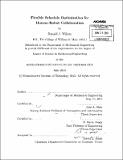Flexible schedule optimization for human-robot collaboration
Author(s)
Wilcox, Ronald James
DownloadFull printable version (9.709Mb)
Other Contributors
Massachusetts Institute of Technology. Department of Mechanical Engineering.
Advisor
Julie A. Shah and H. Harry Asada.
Terms of use
Metadata
Show full item recordAbstract
Robots are increasingly entering domains typically thought of as human-only. This convergence of human and robotic agents leads to a need for new technology to enable safe and efficient collaboration. The goal of this thesis is to develop a task allocation and scheduling algorithm for teams of robots working with or around teams of humans in intense domains where tight, fluid choreography of robotic schedules is required to guarantee the safety of all involved while maintaining high levels of productivity. Three algorithms are presented in this work: the Adaptive Preferences Algorithm, the Multi-Agent Optimization Algorithm, and Tercio. Tercio, the culminatory algorithm, is capable of assigning robots to tasks and producing near-optimal schedules for ten agents and hundreds of tasks in seconds while making guarantees about process specifications such as worker safety and deadline satisfaction. This work extends dynamic scheduling methods to incorporate flexible windows with an optimization framework featuring a mixed integer program and a satisficing hueristic scheduler. By making use of Tercio, a manufacturing facility or other high-intensity domain may fluidly command a team of robots to complete tasks in a quick, efficient manner while maintaining an ability to respond seamlessly to disturbances at execution. This greatly increases both productivity, by decreasing the time spent recompiling solutions, and responsiveness to humans in the area. These improvements in performance are displayed with multiple live demonstrations and simulations of teams of robots responding to disturbances. Tercio acts as an enabling step towards the ultimate goal of fully coordinated factories of dozens to hundreds of robots accomplishing many thousands of tasks in a safe, predictable, efficient manner.
Description
Thesis (S.M.)--Massachusetts Institute of Technology, Dept. of Mechanical Engineering, 2013. Cataloged from PDF version of thesis. Includes bibliographical references (p. 99-101).
Date issued
2013Department
Massachusetts Institute of Technology. Department of Mechanical EngineeringPublisher
Massachusetts Institute of Technology
Keywords
Mechanical Engineering.